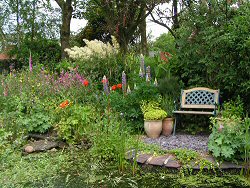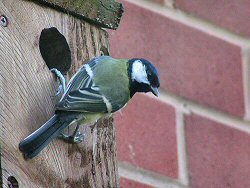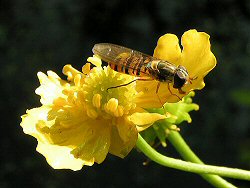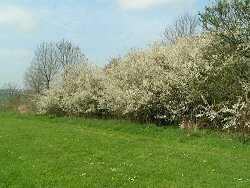Features: Wildlife Trust Articles |  |
Wildlife gardening by design
When you begin a project, do you know exactly what you want to do and how it will all turn out, or do you begin with a rough idea and refine things as you go along? I believe that most people fit into the evolutionist mould; certainly I think that I do.
A place for design
Despite our natural conservatism in the garden, many television programs and books about gardening for wildlife tackle the subject by starting with a blank canvas and designing from scratch. But because most of us never find ourselves in that position, or are not inclined to 'rip it up and start again', we often appreciate the design principles at an intellectual level but forget all about them when we go and 'potter about' in our own gardens.
 A mixture of design and happy accidents - a typical garden pond. A mixture of design and happy accidents - a typical garden pond.
The grand designs of the books and programs are all very well, but in the real world we have our own very personal circumstances to consider: our children may prefer a football pitch to a wildflower meadow; neighbours might baulk at our plans for a woodland garden; perhaps we want to include a space for garden parties.  Whatever our needs are (and they often conflict with each other), we must somehow accommodate them all within our little bit of space Whatever our needs are (and they often conflict with each other), we must somehow accommodate them all within our little bit of space Whatever our needs are (and they often conflict with each other), we must somehow accommodate them all within our little bit of space, and doing so invariably means compromising on the grand designs. Whatever our needs are (and they often conflict with each other), we must somehow accommodate them all within our little bit of space, and doing so invariably means compromising on the grand designs.
But does this mean that we should ignore design principles? On the contrary: it's precisely because the demands on the average family wildlife garden are so varied and our space so limited, that we should pay particular attention to design. We simply need to be prepared to modify ideals and be flexible.  Anyone who is planning work in their wildlife garden should sketch their ideas down on paper, however roughly Anyone who is planning work in their wildlife garden should sketch their ideas down on paper, however roughly Anyone who is planning work in their wildlife garden should sketch their ideas down on paper, however roughly. Spend some time thinking about your long-term goals - there's too much emphasis nowadays on instant gardens, but few of us garden in that way. If you take time out to think about how you want your wildlife garden to look in the long-term (perhaps in five or ten years time), then your short-term pottering is more likely to contribute to your overall goals. Anyone who is planning work in their wildlife garden should sketch their ideas down on paper, however roughly. Spend some time thinking about your long-term goals - there's too much emphasis nowadays on instant gardens, but few of us garden in that way. If you take time out to think about how you want your wildlife garden to look in the long-term (perhaps in five or ten years time), then your short-term pottering is more likely to contribute to your overall goals.
Plan evolutionary changes. While children are young, you want them to enjoy kicking a ball and playing other games which dictates that you keep the lawn for a few years yet; but one day they will be too big, or just disinclined, to play football in the garden and the time for a meadow or pond will come.  By planning in advance for future opportunities, you can ensure that the work you do in the garden in the meantime will complement the changes you aim to make in the future By planning in advance for future opportunities, you can ensure that the work you do in the garden in the meantime will complement the changes you aim to make in the future By planning in advance for future opportunities, you can ensure that the work you do in the garden in the meantime will complement the changes you aim to make in the future. By planning in advance for future opportunities, you can ensure that the work you do in the garden in the meantime will complement the changes you aim to make in the future.
Maximising the available space
When it comes to wildlife gardens, the good news is that size really doesn't matter! Research carried out by scientists at Sheffield University has shown that biodiversity in gardens is not affected by the size of the gardens: small gardens are just as likely to have a good variety of plants and animals as large ones.
 Nest boxes on house walls - like this one being explored by great tit (Parus major) - make good use of the vertical dimension.
So if you have a limited space, don't be discouraged; you can still do much to encourage wildlife to share it with you - the key is to plan effective use of that space. Nest boxes on house walls - like this one being explored by great tit (Parus major) - make good use of the vertical dimension.
So if you have a limited space, don't be discouraged; you can still do much to encourage wildlife to share it with you - the key is to plan effective use of that space.
 One of the best ways of maximising your space is to make as much use of the vertical dimension as possible One of the best ways of maximising your space is to make as much use of the vertical dimension as possible One of the best ways of maximising your space is to make as much use of the vertical dimension as possible. Most of us could make far more use of climbing plants than we do. Bare walls on the outside of a house represent a fantastic opportunity for encouraging wildlife into your garden. By using climbing plants like Ivy (Hedera helix), Honeysuckle (Lonicera periclymenum), Hop (Humulus lupulus) and Virginia Creeper (Parthenocissus quinquefolia), you can transform sterile brick walls into great habitats for many invertebrates and a host of birds. If you train them up a trellis or wires that are supported a few centimetres away from the wall (e.g. by wooden battens) you will provide even more nesting opportunities for birds and the like. You can also train climbers through trees, making even better use of the space occupied by them. One of the best ways of maximising your space is to make as much use of the vertical dimension as possible. Most of us could make far more use of climbing plants than we do. Bare walls on the outside of a house represent a fantastic opportunity for encouraging wildlife into your garden. By using climbing plants like Ivy (Hedera helix), Honeysuckle (Lonicera periclymenum), Hop (Humulus lupulus) and Virginia Creeper (Parthenocissus quinquefolia), you can transform sterile brick walls into great habitats for many invertebrates and a host of birds. If you train them up a trellis or wires that are supported a few centimetres away from the wall (e.g. by wooden battens) you will provide even more nesting opportunities for birds and the like. You can also train climbers through trees, making even better use of the space occupied by them.
 Out of sight should definitely not be out of mind for the wildlife gardener. If you have a deck or a shed, think about maximising the potential of the space underneath for wildlife Out of sight should definitely not be out of mind for the wildlife gardener. If you have a deck or a shed, think about maximising the potential of the space underneath for wildlife Out of sight should definitely not be out of mind for the wildlife gardener. If you have a deck or a shed, think about maximising the potential of the space underneath for wildlife. When I created a low deck adjacent to my pond, I packed the space between the boards and the ground with sticks, small logs and rubble to create living and hibernating opportunities for invertebrates, amphibians and other animals. Another often under-utilised space is that beneath and behind shrubs. You can use these spaces for 'habitat piles' made from prunings, logs, rocks or other materials. By filling some of this empty space with more nooks and crannies, you will encourage invertebrates which, in their turn, will attract more birds, amphibians and mammals. Out of sight should definitely not be out of mind for the wildlife gardener. If you have a deck or a shed, think about maximising the potential of the space underneath for wildlife. When I created a low deck adjacent to my pond, I packed the space between the boards and the ground with sticks, small logs and rubble to create living and hibernating opportunities for invertebrates, amphibians and other animals. Another often under-utilised space is that beneath and behind shrubs. You can use these spaces for 'habitat piles' made from prunings, logs, rocks or other materials. By filling some of this empty space with more nooks and crannies, you will encourage invertebrates which, in their turn, will attract more birds, amphibians and mammals.
Most of us have areas of hard landscaping in the garden, e.g. a patio. Even these areas need not be wildlife-free zones. Plan to make good use of containers in spaces like these. There are virtually no plants that cannot be grown in containers providing you match the containers and soil conditions to the requirements of the plants you put in them.  The great advantage of containers (providing they are not too big) is that you can move them about, so you can, potentially, pack your patio with wildlife-attracting plants The great advantage of containers (providing they are not too big) is that you can move them about, so you can, potentially, pack your patio with wildlife-attracting plants The great advantage of containers (providing they are not too big) is that you can move them about, so you can, potentially, pack your patio with wildlife-attracting plants and simply move them when you want to use the area for entertaining. The great advantage of containers (providing they are not too big) is that you can move them about, so you can, potentially, pack your patio with wildlife-attracting plants and simply move them when you want to use the area for entertaining.
The garden habitat
One of the first principles of designing gardens for wildlife is to work with nature rather than against it. When planning for the wildlife garden we must bear in mind what it is that nature 'wants to do' and try to complement it. A great deal of the wildlife attracted to gardens is, in the wider countryside, to be found in the woodland edge and hedgerow communities.
 A typical garden hoverfly, the marmalade fly (Episyrphus balteatus) resting on greater spearwort(Ranunculus lingula).
This is because the structure of our gardens tends to resemble the structure found there: garden shrubs and trees generally receive a good deal of light like those in the woodland edge and our flower borders and areas of grass resemble the adjacent field margin or woodland glade. A typical garden hoverfly, the marmalade fly (Episyrphus balteatus) resting on greater spearwort(Ranunculus lingula).
This is because the structure of our gardens tends to resemble the structure found there: garden shrubs and trees generally receive a good deal of light like those in the woodland edge and our flower borders and areas of grass resemble the adjacent field margin or woodland glade.
To maximise the potential of our gardens for wildlife, we should plan to capitalise on this resemblance. So  when designing your wildlife garden, a comparison between what you already have and what you see in the wider countryside should never be too far from your mind when designing your wildlife garden, a comparison between what you already have and what you see in the wider countryside should never be too far from your mind when designing your wildlife garden, a comparison between what you already have and what you see in the wider countryside should never be too far from your mind. You will also see the greatest benefits if you try to mirror habitats which are local to you, since it is from your own locality that you will recruit the wildlife that visits your garden. To find out which plants to use, you could just to walk around your local countryside and note what you see. Another way is to consult a brilliant on-line tool run by the Natural History Museum called the 'Postcode Plants Database'. At this website you can type in the first part of your postcode and see a list of all the plants native to your area categorised by type (e.g. trees, shrubs, climbers, perennials etc). when designing your wildlife garden, a comparison between what you already have and what you see in the wider countryside should never be too far from your mind. You will also see the greatest benefits if you try to mirror habitats which are local to you, since it is from your own locality that you will recruit the wildlife that visits your garden. To find out which plants to use, you could just to walk around your local countryside and note what you see. Another way is to consult a brilliant on-line tool run by the Natural History Museum called the 'Postcode Plants Database'. At this website you can type in the first part of your postcode and see a list of all the plants native to your area categorised by type (e.g. trees, shrubs, climbers, perennials etc).
Another excellent way to attract wildlife to the garden is to plan for a wet area such as a pond which mirrors the ditch and pond micro-habitats often present at the woodland edge in the countryside. There is perhaps no other single habitat feature you can add to your garden to provide such a boost for garden wildlife.
The Sheffield University study mentioned earlier found that biodiversity in gardens was typically higher than in natural and semi-natural habitats. This is probably due to all the 'added extras' to be found in our gardens.  By emulating natural habitats found locally, you will provide a solid foundation for your wildlife garden but by integrating traditional garden elements you will supply that little extra that puts gardens among the most biodiverse habitats in the world By emulating natural habitats found locally, you will provide a solid foundation for your wildlife garden but by integrating traditional garden elements you will supply that little extra that puts gardens among the most biodiverse habitats in the world By emulating natural habitats found locally, you will provide a solid foundation for your wildlife garden but by integrating traditional garden elements you will supply that little extra that puts gardens among the most biodiverse habitats in the world. Plan for borders or containers full of nectar and pollen-rich flowers, compost heaps, nesting boxes, feeding stations, climber-covered walls and fences: almost any garden has room to incorporate most of these features. By emulating natural habitats found locally, you will provide a solid foundation for your wildlife garden but by integrating traditional garden elements you will supply that little extra that puts gardens among the most biodiverse habitats in the world. Plan for borders or containers full of nectar and pollen-rich flowers, compost heaps, nesting boxes, feeding stations, climber-covered walls and fences: almost any garden has room to incorporate most of these features.
Gardens in a green network
No garden exists in a vacuum. We have seen how you can plan a successful wildlife garden by mirroring the wider countryside in your area, but  there is another context in which you should think about your own space: the green network of gardens and open spaces which runs through all our urban and suburban areas there is another context in which you should think about your own space: the green network of gardens and open spaces which runs through all our urban and suburban areas there is another context in which you should think about your own space: the green network of gardens and open spaces which runs through all our urban and suburban areas. These green networks are essential 'wildlife corridors' which allow animals and plants to colonise the very hearts of our towns and cities. there is another context in which you should think about your own space: the green network of gardens and open spaces which runs through all our urban and suburban areas. These green networks are essential 'wildlife corridors' which allow animals and plants to colonise the very hearts of our towns and cities.
 Hedges in the wider countryside form ecological 'corridors' and gardens can serve the same function in urban areas. Hedges in the wider countryside form ecological 'corridors' and gardens can serve the same function in urban areas.
Your garden is likely to be a small but important element in such a network. Imagine a row of gardens behind a single terrace block which all have a hedge at their bottom end: that hedge provides a useful wildlife corridor linking all the gardens. If one gardener decides to remove their part of the hedge, the quality of that feature is greatly reduced. Conversely as a wildlife gardener, you can look for ways of linking your garden to those of your neighbours to enhance the continuity of the wildlife habitat.
In some areas of the country, neighbours have actually got together to promote wildlife within their communities. For example in 2004 a group formed called the 'Friends of Hull's Wildlife'. Facilitated by the Hull Biodiversity Partnership, the group aims to encourage people to take an active part in supporting the wildlife in their areas in a variety of ways including wildlife gardening.
 By planning evolutionary changes in our own gardens we can enhance them for wildlife whilst ensuring they provide a valuable and enjoyable space to meet the changing needs of all the family By planning evolutionary changes in our own gardens we can enhance them for wildlife whilst ensuring they provide a valuable and enjoyable space to meet the changing needs of all the family By planning evolutionary changes in our own gardens we can enhance them for wildlife whilst ensuring they provide a valuable and enjoyable space to meet the changing needs of all the family. In the future perhaps we may see more opportunities developing for gardeners to engage in cooperative planning with their friends and neighbours. When this happens, the value of gardens to wildlife may take a huge leap forward, bringing even more of the sights and sounds of the countryside to our very doorsteps. By planning evolutionary changes in our own gardens we can enhance them for wildlife whilst ensuring they provide a valuable and enjoyable space to meet the changing needs of all the family. In the future perhaps we may see more opportunities developing for gardeners to engage in cooperative planning with their friends and neighbours. When this happens, the value of gardens to wildlife may take a huge leap forward, bringing even more of the sights and sounds of the countryside to our very doorsteps.
| First published January 2005. | |
Copyright Richard Burkmar. Permission is hereby granted for anyone to use this article for non-commercial purposes which are of benefit to the natural environment as long the original author is credited. School pupils, students, teachers and educators are invited to use the article freely. Use for commercial purposes is prohibited unless permission is obtained from the copyright holder. |
Back to home page
Do you live in Merseyside? Interested in its wildlife? |